While depending on universal product identifiers like UPCs, GTINs, MPNs, and barcodes for automated product matching is cost-effective and efficient, it falls short when dealing with own-brand items, exclusive premium brands, or uncommon packaging sizes. When these identifiers are accurately present, and competitors must list GTINs/UPCs, this standard method is insufficient for larger retailers. In such cases, Product Data Scrape offers e-commerce product-matching data services, ensuring accuracy and effectiveness for enterprise-level retailers. With a focus on precision and scalability, our service for product matching in e-commerce ensures accurate product matching even in the face of intricate challenges, providing a robust solution for enterprise-level retailers to streamline their operations and enhance customer experiences across Canada, USA, UK, UAE, Germany, & Australia.
Navigating product matching is an inherently intricate endeavor. Our clientele manages extensive and intricate assortments within strict timeframes, demanding swift and scalable product-matching solutions. However, prioritizing speed should maintain accuracy; thoroughness is critical. When others stumble, our product data matching services emerge as the trusted collaborator, persistently dedicated to achieving successful matches. Collaboratively, alongside our adept product data-matching e-commerce specialists, we will establish your product-matching framework. This empowerment places you in the driver's seat, enabling you to precisely define the ideal match's criteria, ultimately ensuring a seamless and effective matching process.
Attribute-Based Matching is a strategy that involves a meticulous comparison of specific attributes and characteristics associated with various products. These attributes encompass vital product details such as names, descriptions, categories, brands, and distinguishing features. These attributes are analyzed using sophisticated algorithms to ascertain the degree of similarity and relevance between products. For instance, when two products share comparable attributes like brand identity, model specifications, and distinctive features, they are deemed a successful match. This method ensures precision by focusing on critical aspects that define the products, enhancing the accuracy of match results.
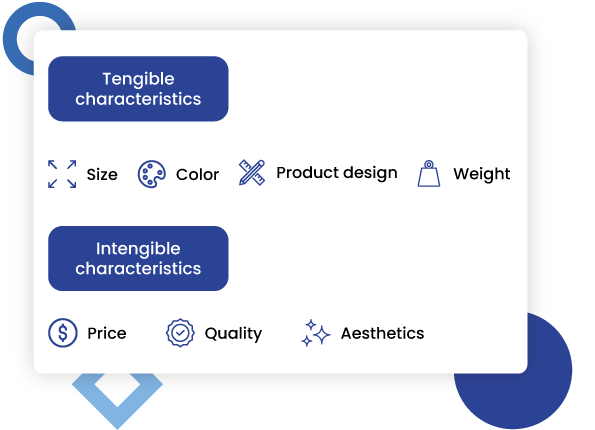
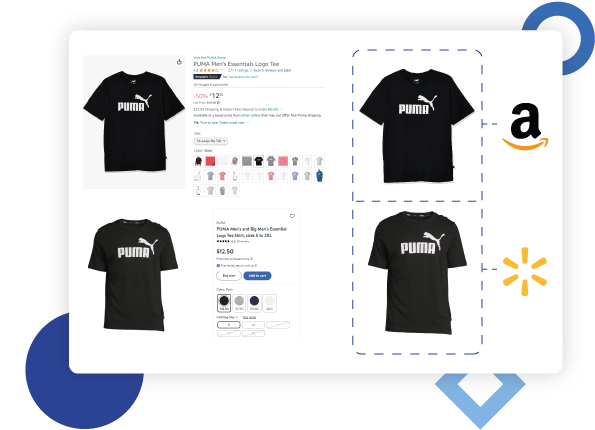
The Image-Based Matching technique harnesses the visual essence of products, utilizing elements like images, thumbnails, or photographs to facilitate matches. We scrutinize the intricate visual attributes such as shapes, colors, patterns, and other visual cues through cutting-edge image recognition technology. It allows for determining the likeness between products solely based on visual characteristics. Particularly effective in scenarios where products share visual resemblances despite variations in attributes or descriptions, this method ensures that visually similar items are accurately identified and matched.
Text-Based Matching carefully analyzes textual information linked to products, encompassing titles, descriptions, and attributes. Employing advanced Natural Language Processing (NLP) techniques, the method identifies common keywords, phrases, or contextual relationships within the text. It aids in ascertaining the semantic relationship between products, allowing for successful matches based on textual cues. Text-based matching is particularly valuable for products with varying attributes but similar descriptions, facilitating precise search results for customers relying on textual inputs.
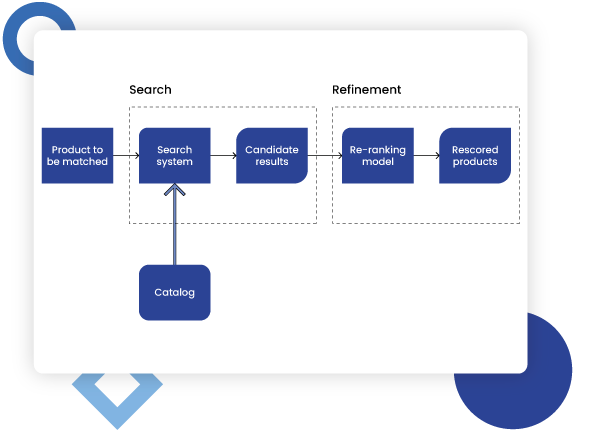
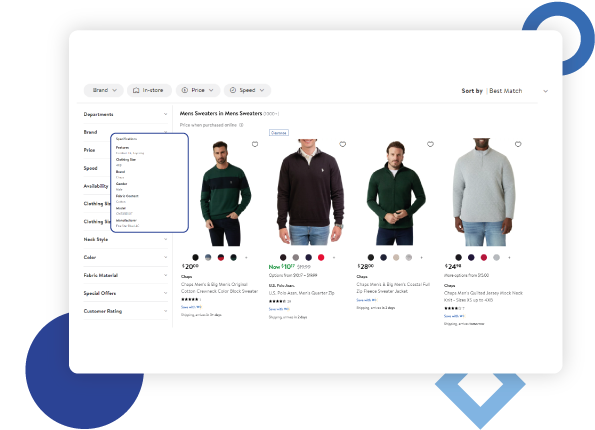
Catalog-Based Matching is a strategy that centers on meticulously comparing product catalogs derived from disparate sources, such as suppliers or retailers. Algorithms establish matches across these diverse catalogs by analyzing vital identifiers like product codes, SKUs, UPCs, and categories. This approach is crucial when integrating products from multiple sources to ensure consistency and accuracy. Catalog-Based Matching enhances the alignment of product offerings, streamlining the process of curating a comprehensive and unified catalog of products from various origins.
Rule-Based Matching involves creating a structured set of predefined rules or criteria that govern the determination of product matches. These rules are crafted by considering various factors, including attributes, prices, categories, and other pertinent elements. A product is identified as a match when it aligns with these established rules. This method empowers businesses to control the matching process, customizing the logic to suit their specific requirements. While offering flexibility and customization, the efficacy of Rule-Based Matching lies in the careful formulation of rules to ensure accurate matches and mitigate the risk of erroneous outcomes.
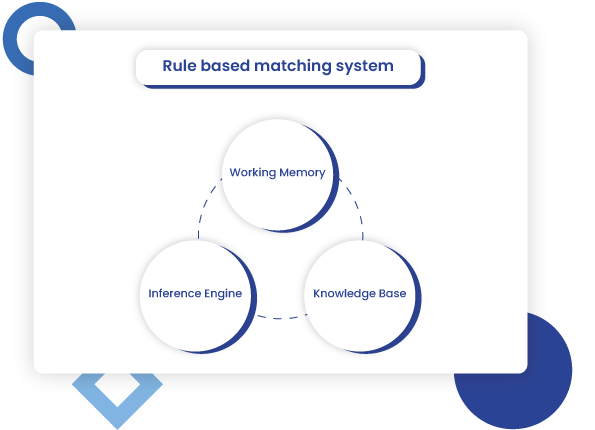
Choose Product Data Scrape for Retail Data scraping to access accurate data, enhance decision-making, and boost your online sales strategy.
With our Retail data scraping services, you gain reliable insights that empower you to make informed decisions based on accurate product data.
We help you extract Retail Data product data efficiently, streamlining your processes to ensure timely access to crucial market information.
By leveraging our Retail data scraping, you can quickly adapt to market changes, giving you a competitive edge with real-time analysis.
Our Retail Data price monitoring tools enable you to stay competitive by adjusting prices dynamically, attracting customers while maximizing your profits effectively.
With our competitor price tracking, you can analyze market positioning and adjust your strategies, responding effectively to competitor actions and pricing.
Utilizing our Retail Data review scraping, you gain valuable customer insights that help you improve product offerings and enhance overall customer satisfaction.
92% of employees believe this is an excellent workplace.
Top Web Scraping Company USA
Top Data Scraping Company USA
Best Enterprise-Grade Web Company
Leading Data Extraction Company
Top Big Data Consulting Company
Best Company with Great Price!
Best Web Scraping Company
Discover how our clients achieved success with us.
“I used Product Data Scrape to extract Walmart fashion product data, and the results were outstanding. Real-time insights into pricing, trends, and inventory helped me refine my strategy and achieve a 6X increase in conversions. It gave me the competitive edge I needed in the fashion category.”
“Through Kroger sales data extraction with Product Data Scrape, we unlocked actionable pricing and promotion insights, achieving a 7X Sales Velocity Boost while maximizing conversions and driving sustainable growth.”
The Resource Center offers up-to-date case studies, insightful blogs, detailed research reports, and engaging infographics to help you explore valuable insights and data-driven trends effectively.
Learn how multi-platform SKU price monitoring enables brands to track competitors in real time, adjust prices instantly, and maintain competitive pricing across channels.
Extract minibar alcohol availability data USA in real time, delivering neighborhood-level market intelligence, demand signals, and insights now.
AI-powered shelf analytics enable U.S. grocery chains to monitor shelves in real time, predict demand, and prevent stockouts before sales are lost.
Real-Time Shrinkflation Tracking Using Grocery SKU Data uncovers hidden size reductions, price changes, and packaging shifts across major U.S. retail chains.
Shopee & Lotus Malaysia real-time datasets power smarter retail decisions with live pricing, trends, and competitor insights.
Case study on how to scrape product details from Shopee Indonesia, including product names, prices, shipping costs, and stock availability for analysis.
2025 Global Grocery Price Comparison reveals pricing trends across the USA, Canada, Europe, and Southeast Asia, highlighting regional differences and market insights.
Research report on real-time UAE retail prices scraped from supermarkets and online marketplaces to track trends, competition, and pricing shifts.
Track real-time price fluctuations across Singapore grocery chains with our report on Real-Time Price Shock Across Singapore Grocery Chains to understand market volatility and consumer impact.
Before vs After Web Scraping: See how e-commerce brands boost growth with real-time data, pricing insights, product tracking, and smarter digital decisions.
Easily scrape data from any eCommerce website to track prices, monitor competitors, and analyze product trends in real time with Real Data API.
Explore how Walmart and Amazon compete in online e-commerce, comparing sales, growth trends, and strategies to see who truly leads the market.
Real-time grocery price APIs help India and UAE retailers track prices, stock, and trends in 2025 to drive smarter pricing and retail intelligence decisions.
We scraped 1,00,000 Christmas gift listings and identified the 7 best-selling products predicted to dominate 2025 holiday sales trends.
Analyze Whiskey vs Wine Christmas demand with scraped search and pricing data—see which festive favorite leads in popularity and sales trends.
Our E-commerce data scraping FAQs provide clear answers to common questions, helping you understand the process and its benefits effectively.
Let’s discuss your requirements in detail to ensure we meet your needs effectively and efficiently.
Trusted by 1500+ Companies Across the Globe